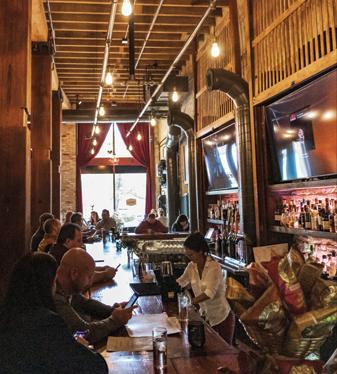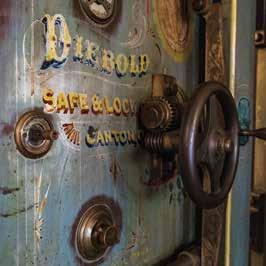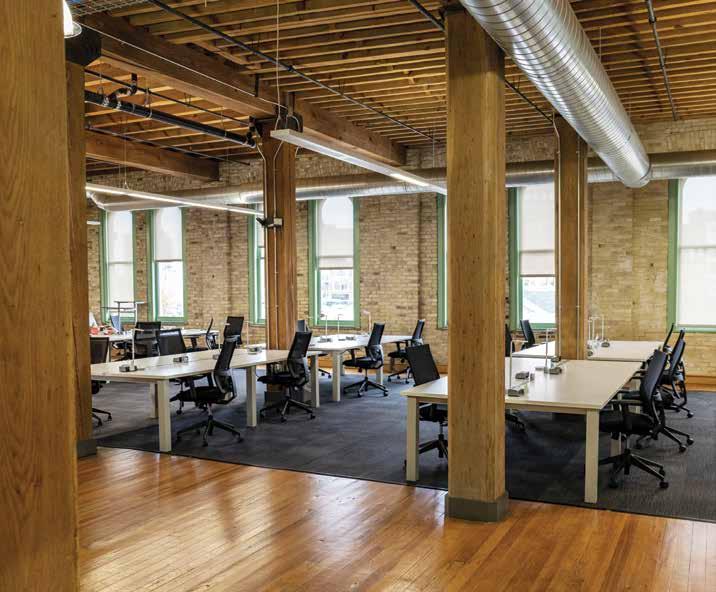
6 minute read
THREE Magazine - Volume 1 | Issue 2
THE PRESENCE OF the Pritzlaff
By Bobby
Advertisement
THE NEWLY INSTALLED LIGHTING that shoots beams of color up the yellow cream city bricks at the Pritzlaff Building, 333 N. Plankinton Ave., also illuminates the contrast between the huge complex’s current appearance with how it looked just a few years ago.
A little over a decade ago the more than 300,000-square-foot complex was lifeless, its windows in need of repair, its bricks blackened by decades of soot, weeds popping through the concrete.
The lights are a shining manifestation of just how much owner Kendall Breunig has achieved at the Pritzlaff complex, the oldest building of which dates to 1875.

Breunig’s Sunset Investors bought the six connected buildings in 2005 and set to work renovating and populating them. Now, there are shops, coworking spaces, restaurants, offices, event venues and dozens of apartments. But getting there wasn’t easy.
“The interior and exterior were pretty bad,” says Breunig. “There were about 50 broken windows and the city had issued an order to board up all the windows. Lots of pigeons were inside and several homeless squatters.”
Breunig hauled out more than 200 Dumpsters worth of junk remaining from the previous owners, Hack’s Furniture. “But the roof was good and did not leak,” he adds, “so the timber frame was solid.”
In 1875, Prussian immigrant John Pritzlaff built the first of the cream city brick buildings on the site as a new home for his hardware business, which had been located on Third Street. As Pritzlaff’s business continued to grow, so did his real estate holdings on Plankinton and St. Paul avenues. In time, his hardware kingdom would occupy all corners of the intersection.

Pritzlaff died in 1900 leaving behind a fortune and a thriving business that his son Fred would run until his own death a half-century later. Fred’s son Edward became president in 1952 and sold the company six years later.
The new owners shut down Pritzlaff Hardware and sold the complex to Hack’s, which closed in 1984, leaving the buildings mostly vacant and decaying.
Tanzilo | Photography By Eric Halverson
In addition to conventional bank financing, Breunig used state and federal historic tax credits to fund the project. These credits, say UWMilwaukee architecture professor Matt Jarosz, are often the key to the expensive renovation of historic buildings.
It’s a funding source that has become widely used in the Third Ward and has helped the neighborhood retain its historic building stock.
“We would have fewer buildings developed,” says Jarosz, who is also the Third Ward Architectural Review Board staff and executive director of the Wisconsin Trust for Historic Places. “Ken was a pioneer. Without the tax credits, I don’t think that that project would have been done. He had the vision; he knew that there was something good there and just looks after it lovingly.”
But there was a time, when the economy was in a tailspin, that Breunig began to question his decision to take on such a huge project. In 2009, he says, funding had dried up.
“I was pumping in up to half a million a year for several years just to hold it,” he recalls. “(The years) 2010-2013 were pretty tough, and I did consider trying to find a way to get out. That was most definitely a time where I had second thoughts of what I had gotten into.”
But then things turned around. In 2012, he opened two event halls and two years later, Ward4 coworking spaces opened.
SINCE THEN, THE PRITZLAFF HAS ADDED 100 APARTMENTS, RETAIL STORES, A NEWLY BUILT PARKING STRUCTURE AND, ON THE FIRST FLOOR, APERITIVO RESTAURANT AND THE EXPLORIUM BREWPUB. NOW, THE PRITZLAFF IS NEARLY FULL.

The buildings are stunning period pieces. Beyond the gorgeous cream city brick – and some vintage Pritzlaff ghost signs – on the outside, inside there are the kind of hulking solid old growth beams you couldn’t get today. Plus, there are vintage safes with hand painted doors, hardwood floors and interesting hardware store remnants, like a cyclone slide that was used to send merchandise to the lower floors from storage areas above.
Breunig, who has a passion for history, has displayed countless Pritzlaff Hardware objects and memorabilia throughout the complex.
“Ken has completely transformed the building and gave as much care and thought to the restoration as anyone could,” says Richard Kerhin, who owns and operates Aperitivo. “His attention to detail and history, along with a willingness to make the financial commitment it often takes to restore an old building are a rare thing nowadays.
“SOMEONE ELSE MIGHT HAVE FOUND A LOT OF WAYS TO CUT CORNERS AND MAKE MORE MONEY, (BUT) KEN RECOGNIZES THE VALUE IN DOING THINGS WELL. IN MANY WAYS HIS WORK ETHIC AND PHILOSOPHY MIMIC THE IMMIGRANT WORK ATTITUDES AND SKILL THAT MADE MILWAUKEE A GREAT CITY.”
The same things lured Mike Doble to open his second The Explorium Brewpub at the Pritzlaff. “You just can’t buy the authenticity of the place, and that’s what we’re all about,” Doble says. “My attraction to the Pritzlaff Building is that the warmth of the space speaks for itself.”
APERTIVO IN THE PRITZLAFF BUILDING
Breunig is always looking for ways to improve the Pritzlaff, too. Hence the lighting, which was designed in-house by Breunig and his electrical contractor, Brighter Connections.


After a year of planning and testing – and some equipment delays caused by the pandemic – the lights were installed this summer.
“We have started to do programming beyond just the static color selections,” Breunig says. “I am looking forward to a wave of green and gold rolling across the building. We will be joining a number of other downtown buildings in coordinating lighting for different events. Our first test was green for the Milwaukee Bucks.”
Still, Breunig is not done. He’s got one more project on his wish list for the Pritzlaff Building. “I would like (to) put the water towers back on top,” he says, though there’s no timeline for that work to begin. “I have the original water tower design drawings, so I can get them to be pretty accurate.”
WARD4 IN THE PRITZLAFF BUILDING
RESTORED SAFE DOOR AT THE PRITZLAFF

